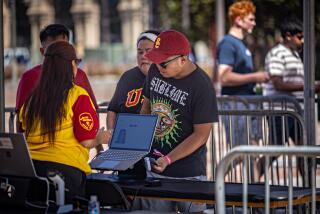Higher Learning: After shootings, many colleges are taking another look at security measures

The recent mass shooting at an Oregon community college has focused attention once again on how to secure expansive, multi-building institutions of learning that by their nature are designed to be open and accessible.
The Oregon case and others have prompted many school officials to reexamine security measures to determine what combination of prevention and response can deter such violence, or at least limit injuries and the loss of life.
Nine people were killed and nine were injured in the Oct. 1 rampage at Umpqua Community College in Roseburg, Ore. The gunman, 26-year-old Christopher Harper-Mercer, then fatally shot himself after he was wounded in a shootout with police. Little more than a week later, shootings at universities in Arizona and Texas left two people dead and four injured.
School shootings are often broadly defined, and accurate counts are elusive. In a 2013 study, the FBI identified 160 “active shooter” incidents from 2000 to 2013 in which one or more shooters killed or attempted to kill people in a populated area. Thirty-nine occurred at colleges and universities as well as K-12 schools, and these educational settings accounted for some of the highest casualty counts, according to the study.
But trying to secure a college campus poses many complications. Whether rural or urban, colleges exist as an integral part of a community, often occupying hundreds of acres, with multiple points of entry and exit and classrooms, libraries and other buildings in use late into the evening.
“Locking down” a campus or installing sufficient checkpoints to be effective is unrealistic, experts say.
“You can make a secure environment with checkpoints everywhere, but you know what we call places that do that? Prisons,” said William F. Taylor, president of the International Assn. of Campus Law Enforcement Administrators and chief of police at San Jacinto College in Texas. “That’s not in the nature of the American academic community. It’s also a very expensive process.”
Many institutions have increased active shooter drills to improve response by campus police. But many increasingly are also training students, faculty and staff on how to respond to an immediate threat in recognition that in most cases they are targets or are on the scene before law enforcement.
USC, for example, recently held a training class for staff of the Annenberg School for Communication and Journalism in the event of an active shooter.
The most up-to-date research calls for different reactions depending on the circumstances, the first being to run, or if that isn’t possible to hide or barricade yourself, and when the threat is unavoidable and imminent, to fight, said USC Deputy Chief David Carlisle.
Matthew Carmichael, police chief at UC Davis, developed an active shooter survival workshop that has been presented around the country and includes self-defense tactics, methods to disable someone with a gun and a “winning attitude.” An immediate focus on survival can be crucial in such scenarios, Carmichael and other experts said.
The campus of more than 34,000 students is also changing its emergency phone system to one based on radio frequency rather than cellular signal, which can be disrupted during emergencies and large-scale events, Carmichael said.
At Humboldt State, an intervention team meets once a week to share information about students who may be exhibiting troubling behavior, said Joyce Lopes, vice president of administrative affairs and the school’s director of emergency operations.
“We orient faculty about the group every academic year and students in residence halls at the beginning of each semester so that they know about those resources,” Lopes said. “Residence assistants share information and if they’re seeing a pattern it may mean we need to intervene earlier.”
Experts said that friends, classmates and family usually have some inkling of disturbing behavior that could have been flagged.
“There’s a lot we can do to bolster physical security, but at the end of the day what we know about shooters is that many of them tell someone and they’re usually on social media,” said Steven J. Healy, a security consultant and chairman of the advisory board for the National Center for Campus Public Safety.
“One of the big hurdles moving forward is as human beings we’re reluctant to believe someone we know can do something as heinous as a mass killing,” Healy said. “But I think we’re getting to the point now where people are becoming less reluctant.”
One emerging response to the Oregon shooting is a greater effort to use social media sites to detect potential threats before they happen — this after numerous instances in which warnings turned into actual attacks, Taylor said.
Many schools have staff monitor websites such as Twitter, Facebook and phone apps such as Yik Yak. Others, such as San Jacinto, are looking to contract for more sophisticated threat alert systems that use algorithms and thousands of keywords, phrases and behaviors to pinpoint potential threats on publicly available websites and forums.
Gary Margolis, president and chief executive of Social Sentinel, a Vermont threat alert company, said campus officials understand that most students spend huge amounts of time in digital conversations.
“Today, there is too much volume, to much information online to be effective in simply scanning sites themselves,” said Margolis, who formerly was police chief at the University of Vermont.
Legislation signed in July by Gov. Jerry Brown calls for California’s 113 community colleges to adopt emergency guidelines that include an active shooter response plan.
Even before the most recent spate of campus violence, the nine-campus Los Angeles Community College District had appointed a committee to look at ways to improve emergency preparedness and is scheduled to release a report within weeks, said Scott Svonkin, president of the district’s Board of Trustees.
Some recommendations are likely to include increasing the number of high resolution cameras as well as the number of sheriff’s deputies on patrol. The district may also consider changing the physical layout of some campuses to limit entrances and better secure perimeters.
“Keeping college students and faculty safe is an ongoing and constant effort that will never be over,” Svonkin said.
Twitter: @carlariveraLAT
More to Read
Sign up for Essential California
The most important California stories and recommendations in your inbox every morning.
You may occasionally receive promotional content from the Los Angeles Times.











